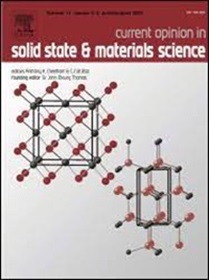Perspectives and challenges of ultra-high temperature ceramics for fusion plasma-facing applications
IF 13.4
2区 材料科学
Q1 MATERIALS SCIENCE, MULTIDISCIPLINARY
Current Opinion in Solid State & Materials Science
Pub Date : 2025-04-28
DOI:10.1016/j.cossms.2025.101223
引用次数: 0
Abstract
Ultra-high temperature ceramics (UHTCs) offer several potential advantages as plasma-facing components (PFCs) in fusion reactors due to their extreme melting points, tailorable thermal conductivity, and attractive unirradiated mechanical properties including fracture toughness comparable or superior to tungsten. Recent developments and material properties of UHTCs are briefly reviewed, along with an overview of limited studies on their responses to neutron irradiation and an evaluation of plasma-surface interactions. Five key research pathways, primarily focused on irradiation effects, for advancing UHTCs in PFC applications are discussed: (1) assessing irradiation effects on the coupled thermal–mechanical performance (2) addressing the lack of studies on irradiation, plasma-surface interactions, and their synergistic effects; (3) investigating high-temperature (>1000 °C) neutron irradiation effects critical for PFC performance; (4) optimizing multi-component UHTC compositions or composites to improve thermal or mechanical properties; (5) enhancing radiation resistance to mitigate microcracking and void swelling through strategies such as increasing sink strength by reducing grain size, introducing fine particles, and leveraging complex concentrated alloy concepts.
超高温陶瓷在融合等离子体中的应用前景与挑战
超高温陶瓷(UHTCs)由于其极高的熔点、可定制的导热性以及极具吸引力的未辐照机械性能(包括与钨相当或优于钨的断裂韧性),在聚变反应堆中作为等离子体面向组件(pfc)提供了几个潜在的优势。简要回顾了超高温超导材料的最新发展和材料特性,并概述了超高温超导材料对中子辐照的响应和等离子体表面相互作用的评价。本文讨论了推进UHTCs在PFC中的应用的五个关键研究途径,主要集中在辐照效应方面:(1)评估辐照对耦合热-力学性能的影响;(2)解决辐照、等离子体表面相互作用及其协同效应研究的不足;(3)研究对PFC性能至关重要的高温(>1000℃)中子辐照效应;(4)优化多组分UHTC组合物或复合材料,以改善热性能或力学性能;(5)通过减小晶粒尺寸、引入细颗粒和利用复杂的浓缩合金概念等策略来提高抗辐射能力,以减轻微裂纹和孔洞膨胀。
本文章由计算机程序翻译,如有差异,请以英文原文为准。
求助全文
约1分钟内获得全文
求助全文
来源期刊

Current Opinion in Solid State & Materials Science
工程技术-材料科学:综合
CiteScore
21.10
自引率
3.60%
发文量
41
审稿时长
47 days
期刊介绍:
Title: Current Opinion in Solid State & Materials Science
Journal Overview:
Aims to provide a snapshot of the latest research and advances in materials science
Publishes six issues per year, each containing reviews covering exciting and developing areas of materials science
Each issue comprises 2-3 sections of reviews commissioned by international researchers who are experts in their fields
Provides materials scientists with the opportunity to stay informed about current developments in their own and related areas of research
Promotes cross-fertilization of ideas across an increasingly interdisciplinary field
 求助内容:
求助内容: 应助结果提醒方式:
应助结果提醒方式:


